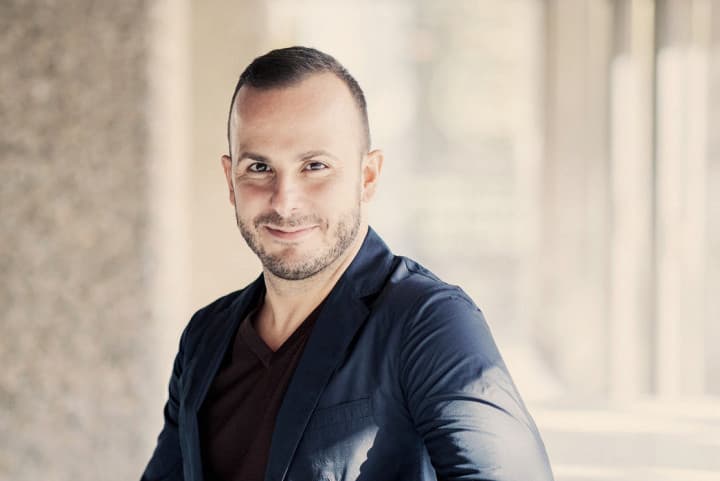The Canadian conductor and pianist Yannick Nézet-Séguin holds the leading positions at two of America’s most storied musical institutions, the New York Metropolitan opera, and the Philadelphia Orchestra.

Yannick Nézet-Séguin
Born on 6 March 1975 in Montreal, Yannick knew from a very early age that he wanted to be a conductor. He began his musical studies at the age of five by taking piano lessons with Jeanne-d’Arc Lebrun-Lussier, but had already decided to become an orchestra conductor at the tender age of ten. He certainly had a passion for music early on, and he recalls “I was swamped by emotion when I was younger. My piano teacher always used to tell me, ‘you have always to keep the mind cold and the heart warm.’ And this is, I think, what we should always strive for as performers.” Music, for Nézet-Séguin, was “almost like a religious calling,” and he continued on his career path by studying piano, conducting, composition, and chamber music at the Conservatoire de musique du Québec in Montreal, where he earned five first prizes in piano and in four related musical subject. Yannick subsequently went on to study choral conducting at the Westminster Choir College in Princeton, New Jersey.
Yannick Nézet-Séguin Conducts Beethoven’s Symphony No. 7 in A Major, Op. 92 “Allegro con brio”
His Piano Study With Anisia Campos

The young Yannick conducts a school performance
Between the ages of 13 and 21, Nézet-Séguin studied with pianist Anisia Campos. Although he had already decided to become a conductor, she insisted he studies as if he were going to be a concert pianist. He recalls, “That was the best education I could have wished for because only through this kind of discipline can a conductor address the best orchestras in the world later. I know what they are going through, instrumentally speaking.” Campos was a strict disciplinarian and proud mentor, and she recalls that Yannick “was a talent. And he worked on that talent, and he had a guide who masterfully guided him. He was the guided student, and I was the guiding teacher.” Driven by a burning passion and love for music, Nézet-Séguin always wanted to share the emotions that have been written in the score with his audience. Initially, “I didn’t have any idea how complex or how multi-layered it would be, and especially how fantastically universal, in a way, it needs to be,” he explains. His idol growing up was Leonard Bernstein “because he conveyed how every bone of the body should express music while on the podium. Why just limit it to the arms, which is what usually people see? It’s the eyes, the eyebrows, the shoulders, and the feet.”
Yannick Nézet-Séguin Conducts Handel’s Ariodante, “Scherza infida in grembo al drudo”
Important Musical Mentor: Carlo Maria Giulini

At the age of 19, Nézet-Séguin met Carlo Maria Giulini, who became one of his most important musical mentors. Nézet-Séguin spent one year in Italy and followed Giulini in rehearsals and concerts. “He was always saying that the clarity of the conductor comes from the clarity of the thought, and if your thought is clear, then the gesture will be clear.” For Nézet-Séguin, the hardest part of conducting is containing his emotions on the podium. “You have to convey completely emotionally what the music conveys, but some part of your brain has to take control, otherwise it’s a potential train wreck.” He remembers that Giulini told him to “imagine the sound between his torso and his hand and that he was sort of holding the sound.” For Nézet-Séguin, studying an orchestral score is like speed-reading a book. “You see the page and you identify right away the thoughts and the keywords. It’s a little bit this way when you first read a musical score. Your brain starts to know, ‘Oh yeah, the first violins are located here and they’re doubled, of course, by the flute and the oboe, and this goes in parallel.’ But it also requires hours and hours and hours and hours of studying in silence, as opposed to the orchestral musician, who has their flute or their violin or their trumpet or their drums, so there’s always a sound.”
Yannick Nézet-Séguin Conducts Florence Price’s Symphony No. 3 in C minor, “Andante ma non troppo”
Getting His Emotional Support

Yannick and Pierre
Nézet-Séguin launched his international career in the early 2000s, and he comes across as a supremely self-confident conductor. However, there were moments during his early career when he experienced periods of anxiety. A documentary filmmaker recalls, “he was 25 and playing with some of the great European orchestras. He would study and study and he would be full of nerves before he would go before these orchestras. There is a moment in Rotterdam when Yannick is waiting outside the stage door to go into the first rehearsal and you can see the fear on his face.” To help him through this period, his parents Serge P. Séguin, PhD, a university professor, and Claudine Nézet, M.A., a university lecturer and coordinator, spent most of a decade traveling with him from city to city. Nézet-Séguin draws his biggest emotional support from his life partner, the violist Pierre Tourville. “Pierre has been at my side for more than 20 years,” he explains, “he has been at my side for half my life. I think I wouldn’t be the conductor I am without Pierre.” Being an openly gay man in the music world, “it is important for both of us to make it as natural as possible. I realize we had the luxury to live in Montreal, where this is accepted, but it is not without challenges… But now I feel this responsibility to talk about it because I receive letters from so many young musicians who struggle with this still, in our days. I think they need to see that, yes, it is possible to live a great life where you can actually reconcile your love life and who you are deeply as a person with who you are as an artist.”
For more of the best in classical music, sign up to our E-Newsletter
Yannick Nézet-Séguin Conducts Shostakovich’s Symphony No. 4 in C minor, Op. 43
